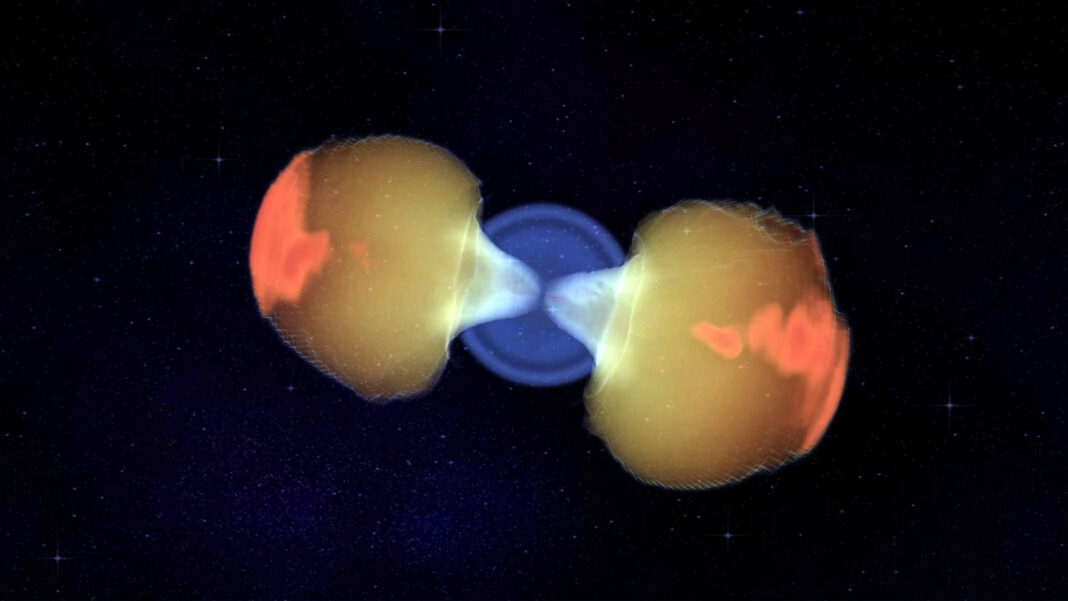The first-ever 3D simulation of the formation of a black hole jet reveals why mysterious gamma-ray bursts appear to blink and suggests that these mysterious phenomena might be much rarer than astronomers thought. Gamma-ray bursts are the brightest and most powerful flashes of light known to exist in the universe . First detected in 1967, these blinding light explosions are generated when massive stars collapse into black holes , launching jets of material that squirt into space at nearly the speed of light .
Currently, satellites spot about one gamma-ray burst somewhere in the universe every day. Astronomers, however, think that up to 500 per day may flash through the universe without us knowing. The new study suggests the actual number might be 10 times lower.
Related: Weird nearby gamma-ray burst defies expectations The study, by a team of astronomers from Northwestern University, simulated for the first time in detailed 3D the birth of black hole jets powered by collapsing stars . The simulation showed that as a massive star collapses, a black hole starts to form at its heart surrounded by a disk of infalling material. In some cases, this material can be accelerated in the black hole’s vicinity into a jet that escapes the black hole’s gravitational pull.
All this is happening while the nascent black hole is still surrounded by the envelope of the dying star. “Previous studies have tried to understand how [the jets] work, but those studies were limited by computational power and had to include many assumptions,” Ore Gottlieb, an astrophysicist at Northwestern University and lead author of the new study said in a statement (opens in new tab) . “We were able to model the entire evolution of the jet from the very beginning — from its birth by a black hole — without assuming anything about the jet’s structure.
We followed the jet from the black hole all the way to the emission site and found processes that have been overlooked in previous studies. ” To trigger a gamma-ray burst, the jet must have enough energy to crack through the collapsing star’s envelope and escape into the surrounding space, the researchers said. “The jet generates a [gamma-ray burst] when it reaches about 30 times the size of the star — or a million times the size of the black hole,” Gottlieb said.
“In other words, if the black hole is the size of a beach ball, the jet needs to expand over the entire size of France before it can produce a gamma-ray burst. ” The simulation revealed for the first time that as material from the collapsing star falls onto the accretion disk around the black hole, it causes this disk to tilt and wobble like a spinning top. This tilt affects the trajectory of the jet, which, in contrast to previous assumption, doesn’t follow a constant direct line.
This wobbling of the jet explains one of the biggest gamma ray burst mysteries — their blinking nature. “Emission from gamma-ray bursts is always irregular,” Gottlieb said. “We see spikes in emission and then a quiescent time that lasts for a few seconds or more.
The entire duration of a gamma-ray burst is about one minute, so these quiescent times are a non-negligible fraction of the total duration. Previous models were not able to explain where these quiescent times were coming from. This wobbling naturally gives an explanation to that phenomenon.
” Just like the beam from a lighthouse, the gamma-ray burst is only visible to astronomers when the jet generating it points toward Earth . The wobbling of the jet, however, also means that many more gamma ray bursts can be observed than scientists previously estimated. “The observed and true rates are different because we can only see the gamma-ray bursts that are pointing at us,” said Gottlieb.
“That means we need to assume something about the angle that these jets cover in the sky, in order to infer the true rate of gamma-ray bursts. That is, what fraction of gamma-ray bursts we are missing. ” — The oldest gamma-ray burst ever discovered was just a piece of space junk — Astronomers catch fizzled-out gamma-ray burst from supernova — The most powerful explosions in the universe emit way more energy than anyone thought This new model suggests that the wobbling increases the observability of gamma-ray bursts up to ten times, which means that only 50 instead of 500 may be flashing through the universe on any given day.
That might be good news for us on Earth as a gamma-ray burst exploding too close to our planet would blow off a big part of Earth’s atmosphere , especially the ozone layer, which protects us from harmful UV radiation. The study was published on Wednesday (June 29) in Astrophysical Journal Letters and uploaded (opens in new tab) to the pre-print server arXiv. org.
Follow Tereza Pultarova on Twitter @TerezaPultarova . Follow us on Twitter @Spacedotcom and on Facebook . .
From: space
URL: https://www.space.com/gamma-ray-bursts-may-be-rare-study/



